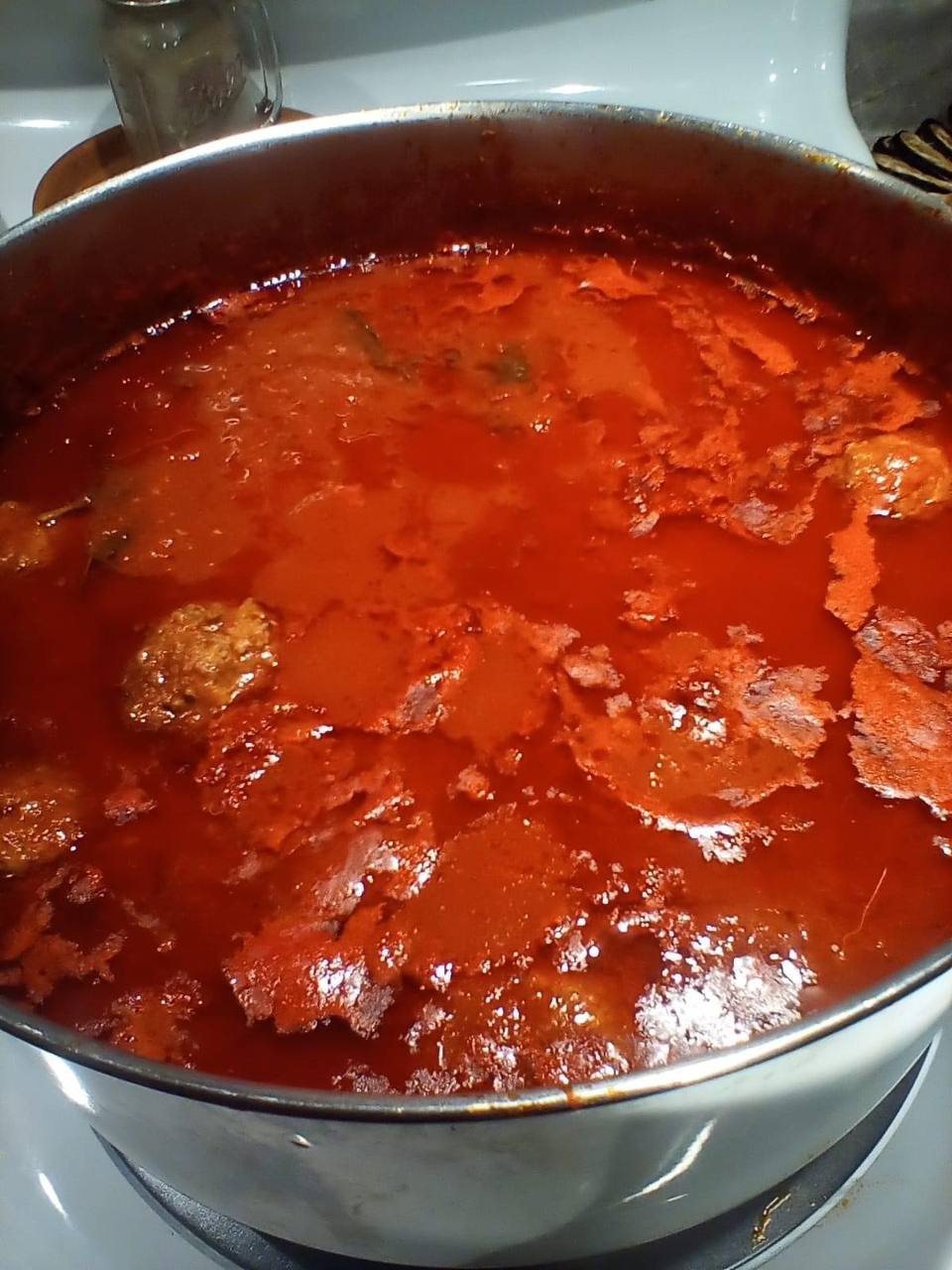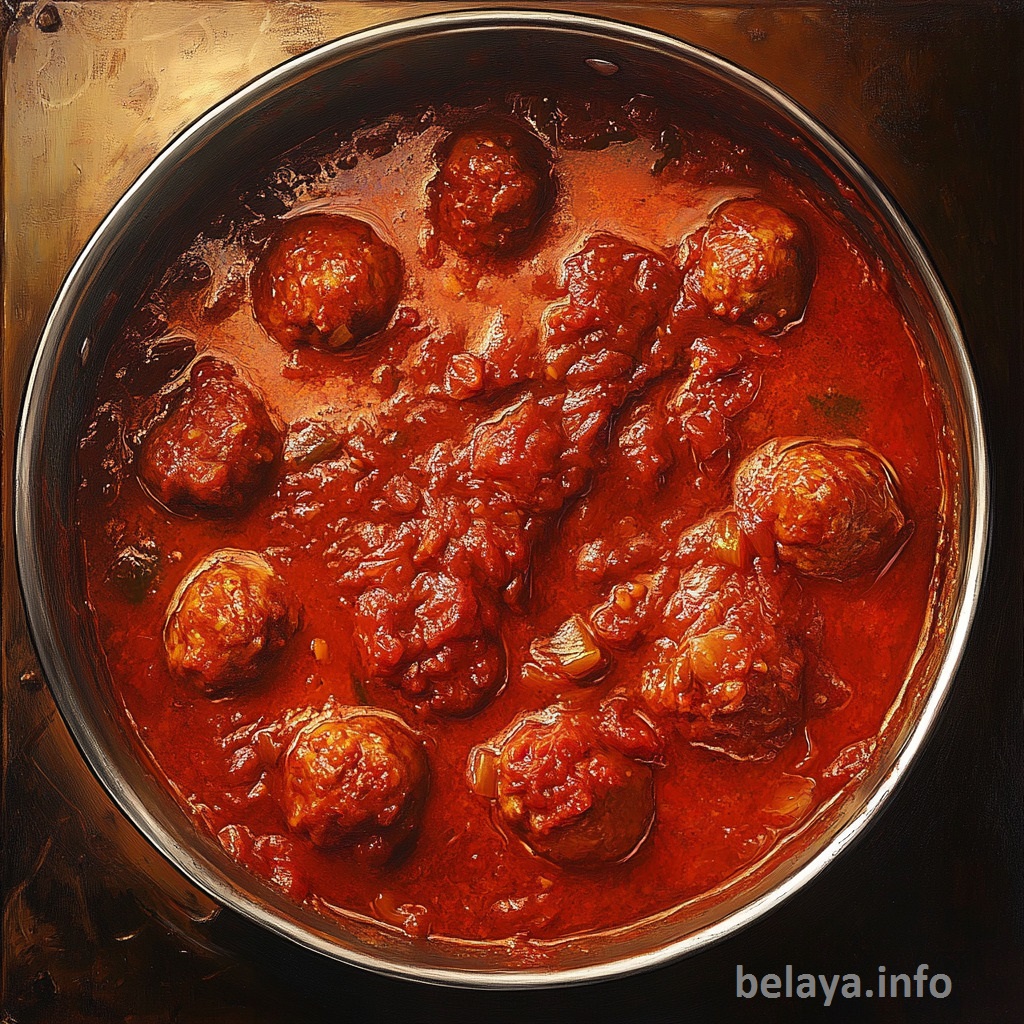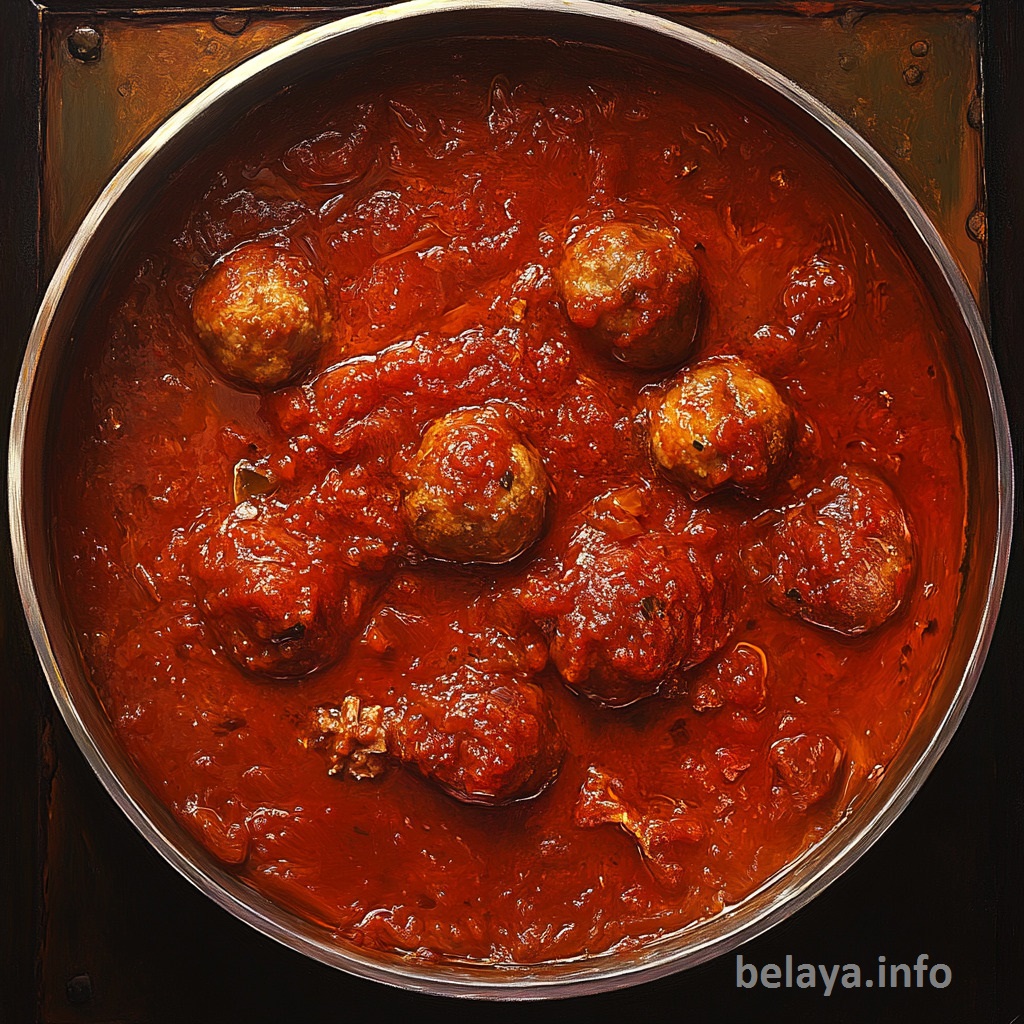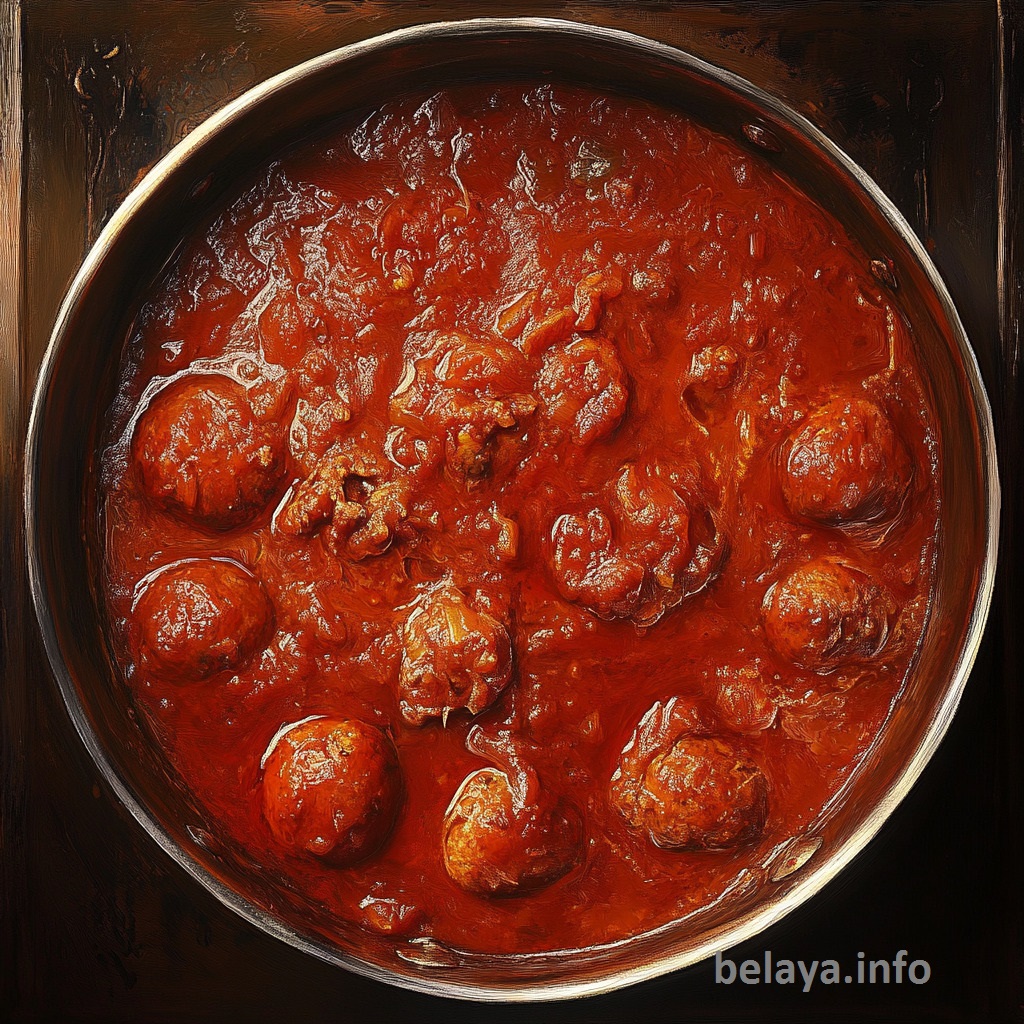San Marzano Tomato Sauce
San Marzano Tomato Sauce is a timeless, slow-simmered classic that showcases the deep, naturally sweet flavor of Italy’s most prized tomatoes. This sauce is a masterclass in simplicity and depth—built from just a few quality ingredients like garlic, olive oil, and herbs, but transformed by the long, patient simmering that coaxes every layer of richness from the tomatoes.
With the addition of sun-dried tomato paste and aromatic basil and oregano, the result is a velvety, robust sauce that’s as elegant as it is comforting.
Whether served over pasta, used in lasagna, or spooned onto crusty bread, this sauce embodies the soul of rustic Italian cooking—humble, nourishing, and unforgettable.

Why People Will Love This San Marzano Tomato Sauce:
Made with Italy’s finest tomatoes: San Marzano tomatoes are naturally sweet, low in acidity, and rich in flavor, giving the sauce a deep, clean tomato taste without bitterness or the need for added sugar.
Slow-simmered for depth and richness: Simmering for 3+ hours allows the flavors to develop complexity, concentrates the natural sugars in the tomatoes, and yields a luxurious, velvety texture that clings beautifully to pasta.
Fragrant and balanced aromatics: The gentle sautéing of garlic in olive oil forms a savory base that infuses the entire sauce with a mellow, aromatic warmth—never overpowering, just deeply comforting.
Customizable to taste and texture: Whether you prefer your sauce chunky and rustic or smooth and refined, this recipe adapts easily with or without blending, and works beautifully with additional ingredients like a parmesan rind or red pepper flakes.
Freezer-friendly and versatile: It stores and freezes well, making it perfect for batch cooking. Use it as a pasta sauce, pizza base, soup starter, or braising liquid—its versatility makes it a staple in any kitchen.
Rooted in tradition, yet elevated with care: The inclusion of sun-dried tomato paste and fresh herbs adds umami and brightness, enhancing the traditional Italian foundation with thoughtful, flavor-boosting touches.

Key Ingredients:
San Marzano Tomatoes (4–5 cans):
The heart of the sauce. Grown in volcanic soil near Mount Vesuvius, San Marzano tomatoes are prized for their naturally sweet, low-acid profile, firm flesh, and minimal seeds. They break down beautifully during cooking, creating a sauce that is both smooth and rich without needing added sugar or heavy seasoning.
Garlic (8 cloves, minced):
Slowly sautéed in olive oil, garlic lays the aromatic foundation of the sauce. When cooked gently, it becomes sweet and mellow, infusing the entire pot with subtle depth and complexity.
Extra-Virgin Olive Oil (3–4 tablespoons):
Used not just as fat but as a flavor conductor, the olive oil extracts and disperses the garlic’s aroma and gives the sauce a silky mouthfeel. It also contributes a grassy, fruity undertone that supports the tomatoes without overshadowing them.
Amore Sun-Dried Tomato Paste (2–3 tablespoons):
This concentrated paste introduces a deep, umami-rich intensity that enhances the tomato flavor and adds subtle smokiness. It’s a small addition that makes the sauce taste like it’s been simmering all day—even if it hasn’t.
Fresh Basil and Oregano:
Added at the end to preserve their brightness, basil brings a soft, sweet herbal aroma while oregano introduces a slightly peppery earthiness. Fresh herbs elevate the sauce from simple to sublime by adding balance and vibrancy.
Salt & Black Pepper (½ teaspoon each, adjustable):
These essential seasonings are used sparingly to amplify natural flavors rather than dominate. They allow the tomatoes and herbs to take center stage.

Expert Tips:
Use whole peeled San Marzano tomatoes—not crushed or diced:
Whole tomatoes offer the most control over texture and are the least processed, preserving their natural sweetness and integrity. Crushing them gently with your hands or a spoon during cooking allows the sauce to break down gradually and naturally.
Sauté garlic low and slow—never brown it:
Garlic should be gently cooked in olive oil over low to medium heat until fragrant (30–60 seconds). If it browns, it turns bitter and can overpower the sauce. The goal is to bloom its flavor into the oil, not fry it.
Simmer uncovered or partially covered to concentrate flavors:
Keeping the lid slightly ajar allows moisture to escape, concentrating the sauce and intensifying its natural sweetness. Stir occasionally to prevent sticking or scorching at the bottom.
Add a Parmesan rind for umami depth (optional but transformative):
Simmering a Parmesan rind in the sauce slowly releases savory, nutty notes and creates a fuller, more luxurious flavor. Just remember to remove it before serving.
Layer your salt and herbs intentionally:
Salt early to help the tomatoes break down, but finish seasoning at the end to adjust for taste. Similarly, add fresh herbs only in the last few minutes of cooking to preserve their brightness and prevent bitterness.
Let time do the work—don’t rush it:
The 3+ hour simmer is key. Over time, the tomatoes will mellow, the acidity will soften, and the ingredients will meld into something far greater than the sum of their parts. The longer it cooks, the more soul it develops.
Use a stainless steel or enameled pot—avoid reactive metals:
Tomatoes are acidic, and cooking them in aluminum or cast iron can lead to a metallic taste. Stick with stainless steel or enameled cookware for clean, untainted flavor.
Taste and adjust at the very end:
After the sauce has reduced and the herbs are stirred in, taste and fine-tune with more salt, pepper, or a touch of olive oil for finish. The final adjustment brings the whole sauce into harmony.

San Marzano Tomato Sauce
Ingredients
8 garlic cloves, minced
3-4 Tablespoons extra-virgin olive oil
4-5 28oz cans San Marzano Peeled Tomatoes (with juices)
2-3 Tablespoon amore sun-dried tomato paste (or use regular tomato paste)
1/2 teaspoons (each) salt & black pepper
3 Tablespoons fresh basil (for dried basil – 1 Tbsp)
2 teaspoons fresh oregano (for dried oregano – 1 tsp)
Instructions
Sauté the Garlic:
In a large stainless steel pot, heat the olive oil over low to medium heat.
Add the minced garlic and cook for 30 to 60 seconds, stirring constantly to prevent browning.
The goal is to release the garlic’s aroma without letting it burn.
Add Tomatoes and Simmer Slowly:
Pour in the San Marzano tomatoes with their juices. Add the tomato paste, salt, and black pepper. Stir well to combine.
Cover the pot partially—leave it slightly open to let steam escape—and reduce the heat to low. Let the sauce simmer gently for at least 3 hours, stirring occasionally to prevent sticking or scorching.
(Optional) Add Parmesan Rind:
For extra depth, add a Parmesan rind during simmering.
Let it infuse the sauce, then remove and discard it before serving.
Blend, if Desired:
For a smoother sauce, use an immersion blender at the end of cooking to puree the mixture.
If you prefer a rustic, chunkier texture, you can skip this step—the San Marzanos will naturally break down into a soft, hearty sauce.
Finish with Fresh Herbs:
Stir in the chopped basil and oregano just before serving to preserve their freshness.
Taste and adjust the seasoning with additional salt and pepper, if needed.

Important Notes When Making San Marzano Tomato Sauce:
Heat Control is Key
Gentle heat preserves the subtle sweetness of San Marzano tomatoes. A too-high flame can scorch garlic and ruin the balance of the sauce.
The low and slow simmer is not optional—it’s essential. Simmering for 3+ hours breaks down the tomatoes and builds rich umami depth.
Garlic Must Be Watched Closely
Garlic burns in seconds. It should only be sautéed until fragrant, not browned. Browning can turn it bitter and overpower the sauce.
Stir constantly and don’t walk away during this step.
Why San Marzano?
True San Marzano tomatoes (from Italy’s Campania region) are naturally sweeter and less acidic than most other canned varieties.
They’re also meatier, which results in a richer, thicker sauce even without excessive reduction.
Tomato Paste = Depth + Concentration
The sun-dried tomato paste adds a layer of deep, slightly smoky umami. It mimics the flavor of slow-roasted tomatoes.
If using regular tomato paste, sauté it briefly after garlic to caramelize and intensify the flavor before adding the canned tomatoes.
Parmesan Rind = Secret Weapon
Adding a rind from Parmigiano Reggiano during simmering infuses a salty, nutty undertone without making the sauce taste cheesy.
Always remove it before blending or serving.
Add Herbs at the End
Cooking fresh herbs too early dulls their flavor and color.
Stir in basil and oregano right before serving to retain their vibrant, aromatic notes.
Texture is Customizable
Rustic lovers: Let the tomatoes break down naturally with a wooden spoon.
Smooth sauce fans: Use an immersion blender right at the end, but only after cooling slightly for safety.
Seasoning Evolves
Taste only at the end. Long simmering concentrates saltiness and acidity.
Adjust salt, pepper, and herbs after the sauce has fully reduced for a balanced final flavor.

How To Enjoy San Marzano Tomato Sauce After Cooking
Serving Suggestions
Over Pasta:
Ladle generously over al dente pasta such as spaghetti, rigatoni, bucatini, or penne. Top with freshly grated Parmigiano-Reggiano and a drizzle of extra-virgin olive oil.
With Meatballs or Sausages:
Serve warm meatballs or Italian sausages smothered in this sauce with a side of crusty bread or polenta.
Pizza Base:
Spread it lightly over homemade pizza dough before adding toppings. Its slow-simmered depth enhances simple cheese or Margherita-style pizzas.
Eggs in Purgatory (Shakshuka-style):
Simmer eggs directly in a skillet of this sauce for a hearty breakfast or brunch. Top with fresh basil and serve with toasted sourdough.
As a Bread Dipper:
Spoon warm sauce into a bowl and serve with grilled focaccia, garlic bread, or breadsticks for an appetizer or snack.
Topping Enhancements
A dusting of grated Pecorino Romano or Parmigiano
A drizzle of chili oil or a pinch of red pepper flakes for heat
A spoonful of ricotta or burrata for creaminess
Freshly torn basil or flat-leaf parsley for color and aroma
Best Pairings
Wine: Chianti, Sangiovese, Barbera, or a dry red blend
Side Dishes:
Caesar salad or arugula with lemon vinaigrette
Roasted vegetables like zucchini or eggplant
Garlic bread or baked polenta
Storing and Reheating
Refrigerate leftovers in an airtight container for up to 5 days.
Freeze in portioned bags or containers for up to 3 months.
Reheat gently on the stovetop over low heat, adding a splash of water or broth if needed to loosen the texture.
Tips for Next-Day Use
The flavor intensifies overnight, making it ideal for next-day lasagna, baked ziti, or meatball subs.
Use it as a base for soup (like tomato-basil or minestrone) or add a splash to stews for extra richness.

Nutrition Information:
YIELDS: 8 | SERVING SIZE: 1
Calories: 100 | Total Fat: 7g | Saturated Fat: 1g | Cholesterol: 0mg | Sodium: 200mg | Total Carbohydrates: 10g | Dietary Fiber: 2g | Sugars: 6g | Protein: 2g
Frequently Asked Questions:
Can I make this soup ahead of time?
Absolutely. In fact, the flavors deepen and improve after resting. Make it a day in advance and store it in an airtight container in the fridge. Reheat gently on the stove or in the microwave—add a splash of broth or water if it thickens too much.
Can I use raw chicken instead of cooked chicken?
Yes, but you’ll need to adjust the cooking method. Add raw, cubed chicken after sautéing the vegetables and cook until fully done before adding the broth and evaporated milk. Be sure to simmer until the chicken is tender and reaches 165°F internally.
How can I make this soup spicier?
To boost the heat, add diced jalapeños, a pinch of cayenne pepper, or a splash of hot sauce during the final simmer. You can also sauté a chopped chipotle pepper in adobo sauce with the vegetables for a smoky, fiery twist.
Is there a dairy-free substitute for evaporated milk?
Yes. You can use unsweetened full-fat coconut milk for a dairy-free option—it gives the soup a creamy texture with a subtle coconut note. Alternatively, blend soaked cashews with water to create a neutral dairy-free cream substitute.
Will this soup freeze well?
Mostly, yes. The base freezes beautifully, but for best texture, consider freezing the soup before adding the evaporated milk, then stir it in fresh when reheating. This avoids potential separation or graininess in the thawed soup.
Why should I sauté the vegetables before adding the broth?
Sautéing the onion, red bell pepper, and poblano pepper first allows them to soften and release their natural sweetness, which builds a deeper flavor base. Skipping this step can result in a soup that tastes flat or raw.
When should I add the cornstarch slurry, and how do I prevent lumps?
Add the slurry after the broth and evaporated milk have been added and are warming up. Always whisk the cornstarch or flour into cold water before adding it to hot liquid, and stir constantly as you pour it in to ensure a smooth, lump-free consistency.
Can I simmer the soup longer than 10 minutes after adding the chicken and beans?
Yes—extended simmering can deepen the flavor, but keep the heat at a low to medium level to avoid overcooking the chicken or causing the milk to separate. Stir occasionally to prevent sticking or scorching.
How do I ensure even seasoning throughout the soup?
Add salt and spices gradually and stir thoroughly at each stage. Because ingredients like broth, beans, and chicken can vary in sodium, it’s best to taste the soup before the final simmer and adjust as needed.
Should I blend the soup or leave it chunky?
This soup is designed to be chunky and hearty, with visible pieces of chicken, beans, and vegetables. However, if you prefer a smoother texture, you can partially blend it with an immersion blender—just be sure to leave some texture intact for contrast.